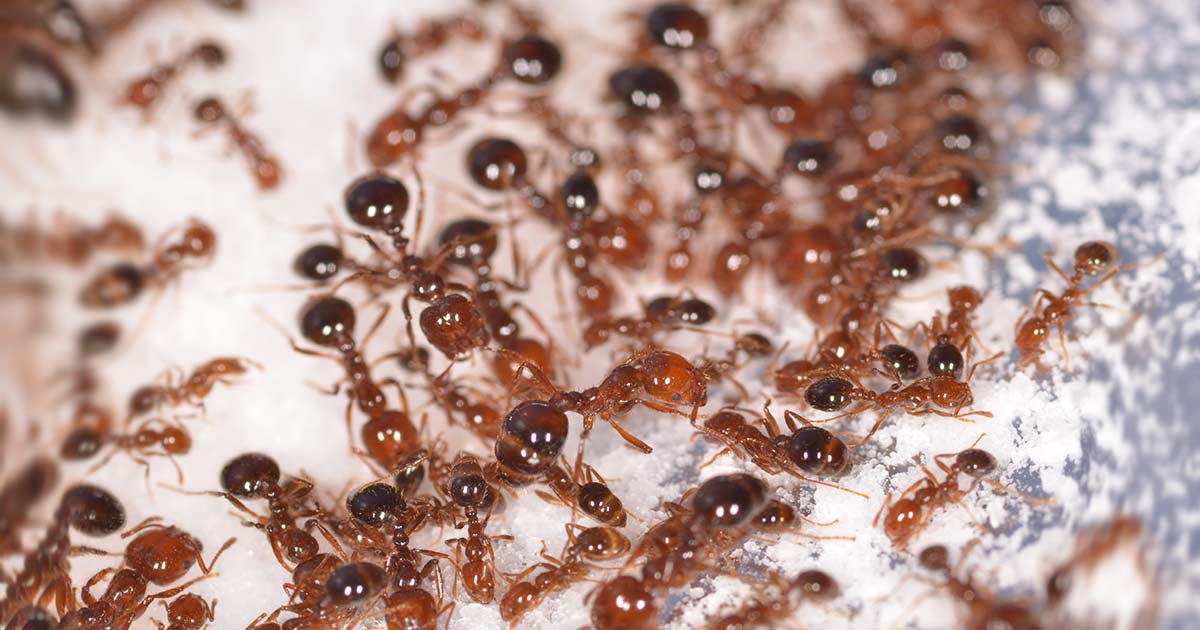How to Identify Fire Ants, Their Mounds and Stings

The possibility of fire ants in your yard can be stressful, especially if you're new to fire ant country. Not only do fire ants fill your lawn with ugly mounds, they threaten to bite and sting friends and family, including your pets. The first step in fire ant control is learning how to identify fire ants, fire ant mounds and fire ant stings so you can be prepared. Then you can protect your property and your family against fire ant invasions.
Home remedies can be tempting if your only focus is quick, cheap pest control. But when fire ants threaten to bite and sting your family and pets, you need fire ant control that actually works. That's a problem if you put your hope in DIY fire ant remedies.
How to Identify Fire Ants
The United States has several native fire ant species, but red imported fire ants are the ones behind your worries. These invasive South American natives were accidentally introduced to Alabama nearly 100 years ago. Since then, red imported fire ants spread through the Southeast and moved north, west and south.
Geography is your first clue in identifying red imported fire ants. If you live in the southern United States, from the Carolinas west through Texas, you're in prime fire ant territory. Fire ants have spread to parts of the Southwest and California as well. If you live in the northern states, red imported fire ants aren't your problem. But that may change as their range expands.
Getting close enough to fire ants to make a visual ID can be hazardous. But these physical characteristics help identify red imported fire ants:
- Reddish-brown color, often with darker red-brown to black-brown abdomens.
- Size variations of worker ants from 1/16 to 1/4 inch long. 1(Most ants have consistent sizes.)
- Narrow, pinched waists with two prominent nodes right before the abdomen.
Ant behavior is also key to fire ant identification. When mounds are disturbed, red imported fire ants swarm up anything vertical — including grass, twigs and outstretched arms or legs of people or pets. Other types of ants move slower and go out, not up.

How to Identify Fire Ant Mounds
Fire ants usually build their mounds in open, sunny areas. The fluffy mounds often pop up right after rainfall or in nicely irrigated lawns. Unlike other types of ant mounds, undisturbed fire ant mounds don't have any visible entry or exit holes. A mound with a distinct center hole is not a fire ant mound.
In well-maintained lawns, fire ant mounds stay relatively small and just a few inches high. In open pastures or unmaintained areas, fire ant mounds often reach 18 inches tall or more. Fire ant colonies nest deeper during times of heat and drought, so mounds may stay hidden from view.
Red imported fire ant colonies can have a single queen or multiple queens. The more queens a colony has, the more mounds they form. Left unchecked, severe fire ant infestations can involve hundreds of mounds per acre, housing tens of millions of fire ants.2 But even large mounds can relocate quickly.
Always be extremely cautious around potential fire ant mounds — even when armed with a long shovel or stick. Red imported fire ants flood out of disturbed mounds, ready to attack. They can run up long tool handles much faster than most people imagine.

How to Identify Fire Ant Stings
If you're stung by a fire ant, you'll probably know what type of ant is behind your pain. Before fire ants sting, they bite to get a firm grip. Then they sting repeatedly. The swarm of ants seems to bite all at once.
The stinging sensation that inspired fire ant's name is often compared to putting a burning match to your skin. Within a day or so, fire ant sting sites develop large, white, fluid-filled pustules — unique to fire ant venom. If broken open, the sites often become infected and lead to scars.
Only about 1% of the population has life-threatening reactions to fire ant venom, but extensive stings put anyone at risk. 1Young children and small animals, including pets, are especially vulnerable. If you're stung by a fire ant, make sure someone else knows. If you start to sweat heavily or feel short of breath, seek medical attention immediately.
When you live in the southern United States, dealing with existing fire ants and new fire ant invasions comes with the territory. But by learning how to identify fire ants — and their mounds and stings — you can find the best fire ant killer to protect your property and kill invasive fire ants and their colonies.

Sources:
1. Texas Imported Fire Ant Research and Management Project, "Fire Ant Frequently Asked Questions," Texas A&M AgriLife Extension.
2. Texas Imported Fire Ant Research and Management Project, "Biology," Texas A&M AgriLife Extension.




